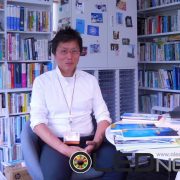We visited Adachi’s laboratory at Kyushu university that published the TADF (abbr., Thermally Activated Delayed Fluorescence) thesis firstly to ‘Nature’ in 2010. He looked like a naive graduate student rather than a professor.

<Prof. Adachi , source : OLEDNET>
The reason that Prof. Adachi’s showing a full of enthusiasm for the TADF materials is that he convinces it is the best materials to lower manufacturing costs of OLED panel. Luminescence materials used in present are divided like fluorescence materials as 1st generation, and phosphorescence materials as 2nd generation. Fluorescence materials as 1st generation have a cost-effective and a low-efficiency, whereas phosphorescence materials as 2nd generation have both high-efficiency and also high-costs. This is because it utilizes the rare-earth metal, iridium. TADF as 3rd generation which Prof. Adachi has been driving, is as a structure of 1st generation materials and it has the merit of achieving the efficiency of 2nd generation materials.
TADF materials have special features that are theoretically capable of reaching 100% inter-efficiency and being free to plan molecular. It means that TADF can raise external light-efficiency up to 40%, because it is possible to form oriented materials by rod-shaped molecular planning.
About the question of the timing of commercialization of TADF materials, Prof. Adachi said that it is still insufficient to apply to OLED of Galaxy, while it’ll be possible to utilize it for products with somehow low specification from next year. It is especially expected that green or red dopant may be available. However, he also emphasized that it is essential to increase the electron transfer speed by reducing the band gap of T1 and S1 in order to be the ultimate TADF for use in displays. The electron transfer speed is currently around 1μsec, but if its speed goes up to 10-1 ~ 10-2 μsec, the lifetime would be secured due to reducing molecular degradation. He expressed about that it is necessary to actively attend by manufacturers of luminescence materials, because there are no dedicated host materials that can sufficiently demonstrate the efficiency of TADF dopant due to difficulties in developing TADF materials.

He recently put a thesis, deep blue TADF with a color coordinate of (0.148, 0.098) and external light-efficiency of more than 19.2% at German journal Angewandte.



